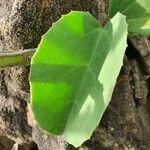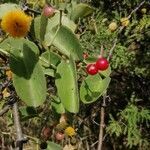A vine which either climbs or lies flat on the ground. It does not have spines. It can become woody but the stems are succulent. They develop 4 or 5 ridges with age. It has tendrils. The leaves are simple and almost round. They are 5-8 cm across. The leaves are glossy, green and succulent. The edges of the leaves have blunt teeth. The flowers are in clusters. The flowers are small and green or white. The berry is oval and 1.2 cm long. It is red or purple.
Leaves simple or occasionally lobed; petiole pubescent, up to 1 cm. long; leaf-lamina up to 8 × 8 cm., circular to ovate, obtuse at the apex, margin crenate, cordate at the base, pubescent or glabrescent on both sides, thick and fleshy; stipules up to 4 mm. long, ± semicircular, glabrous, caducous.
Climber, with tendrils. Leaves thick, succulent, circular to ovate, up to 80 x 80 mm, apex obtuse, margin crenate. Flower bud and ovary glabrous. Flowers greenish yellow.
Cymes leaf-opposed and terminal, lax; peduncle 3 cm. long; pedicels 4–5 mm. long lengthening to 10 mm. in fruit, appressed-pubescent.
Vigorous climber; stems often 4–5-angled, pubescent or glabrescent; tendrils 2-fid.
Seeds 1–2 per fruit, 9 mm. long, smooth with single crest.
Fruit 1·5 × 1·3 cm., red when ripe.
Ovary glabrous; style 0·5 mm. long.
Calyx 1 mm. long, entire.
Flower-bud 3·5 × 1·5 mm.
Petals green.





